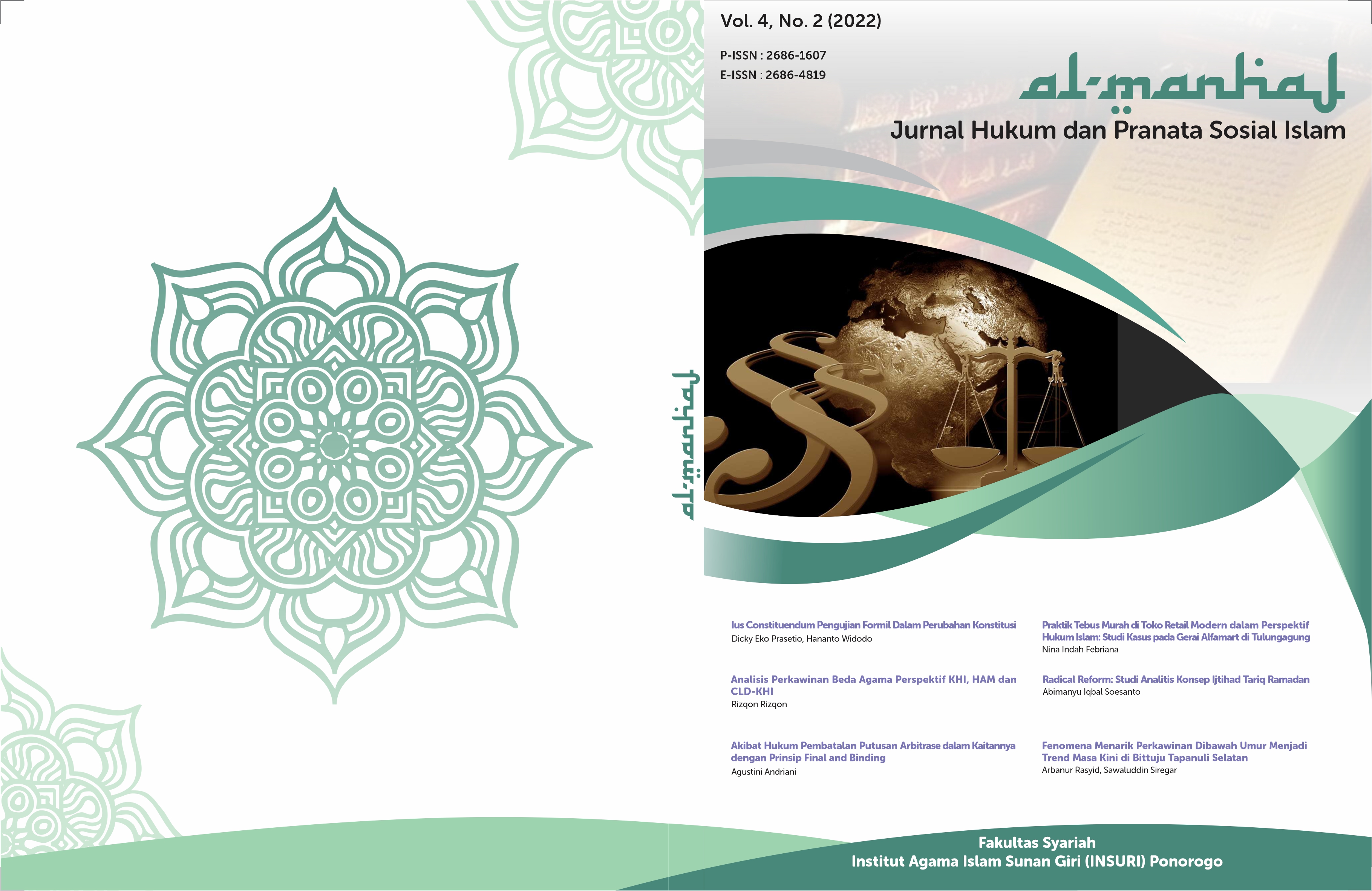Perlindungan Hukum Terhadap Korban Penyalahgunaan Narkotika
DOI:
https://doi.org/10.37680/almanhaj.v4i2.1860Keywords:
Narcotics; Rehabilitation; ConstitutionAbstract
Currently, the circulation of narcotics in Indonesia has penetrated almost all elements of society, starting from the elite, politicians, public figures, students and university students. This condition is certainly very concerning because the use of narcotics can affect the patient's feelings, thoughts and awareness. Narcotics which were originally only used for medical purposes as anesthetics and painkillers or painkillers, are now widely misused. Narcotics and psychotherapy crimes are serious crimes against humanity. Rehabilitation is a repressive measure carried out for drug addicts. Rehabilitation measures are aimed at victims of narcotics abuse to restore the physical, mental, and social abilities of the sufferer concerned, with the hope that the addict can recover from his addiction to narcotics. Indonesia is a state of law, showing evidence of seriousness in tackling narcotics abuse with the issuance of Law No. 35 of 2009 concerning Narcotics which regulates efforts to eradicate narcotics crimes through threats of fines, imprisonment, life imprisonment, and death sentences and regulates the use of narcotics. for the benefit of treatment and health and regulates medical and social rehabilitation. This research uses a normative method, based on a literature study. Information is obtained from various literatures and compiled based on the results of the study from the information obtained. The primary legal materials used are; Law Number 35 of 2009 concerning Narcotics, Joint Regulation of the Chairman of the Supreme Court of the Republic of Indonesia Minister of Law and Human Rights of the Republic of Indonesia Minister of Health of the Republic of Indonesia Minister of Social Affairs of the Republic of Indonesia Attorney General of the Republic of Indonesia Head of the National Police of the Republic of Indonesia Head of the National Narcotics Agency of the Republic of Indonesia Number 01 /Pb/Ma/III/2014 Number 03 of 2014 Number 11 of 2014 Number 03 of 2014 Number Per-005/A/Ja/03/2014 Number 1 of 2014 Number Perber/01/III/2014/Bnn concerning Handling of Narcotics Addicts and Victims of Narcotics Abuse Into Rehabilitation Institutions. Meanwhile, secondary legal materials cover all principles, provisions, and legal technical procedures, both in laws and regulations, agreements and legal searches (doctrine) and literature. The collected legal materials are selected and sorted according to the topic of study to be analyzed using descriptive and argumentative techniques.
References
AR. Sujono dan Bony Daniel, Komentar dan PembahasanUndang-UndangNomor 35 Tahun 2009 tentangNarkotika. (Jakarta: SinarGrafika, 2011) Hal. 127
Andi Hamzah dan RM. Surahman,1994:16
Arief Mansur, Dikdik M. dan ElisatrisGultom, UrgensiPerlindungan KorbanKejahatan Antara Norma dan Realita, Jakarta: Raja GrafindoPersada, 2007Hal. 125
Haris Sasangka, 2003, narkotika dan psikotropika dalam hukum pidana untuk mahasiswa dan praktisi serta penyuluh masalah narkoba, cetakan 1, Mandar Maju, Bandung, hlm 33
M. Ridha Ma’roef (Hari Sasangka, 2003: 33-34)
Tongat, Hukum Pidana Materil, Malang, UMM Press 2008 : Hal14.
Peraturan Bersama Penanganan Pecandu. Penyalagunaan. Narkotika. Lembaga Rehabilitasi
https://peraturan.go.id/common/dokumen/bn/2014/bn465-2014.pdf
PeraturanKepala BNN Nomor 2 Tahun 2011
Soedarto. 2007. Sinopsis Kedokteran Tropis. Surabaya: Airlangga University Press. Halaman: 251-252.
Surat EdaranMahkamah Agung (SEMA) No. 4 Tahun 2010 tentangPenempatanPenyalahgunaan
Sahetapy, Hukum Pidana1995: Liberty, Yogyakarta , Hal 14-125.
Undang – Undang Nomor 35 Tahun 2009 tentang Narkotika pasal 112
Undang-undang Republik Indonesia Nomor 35 Tahun 2009, tentang Narkotika Pasal 114
Undang – Undang Nomor 35 Tahun 2009 tentang Narkotika pasal 54
Undang – Undang Nomor 35 Tahun 2009 tentang Narkotika pasal 127
Undang – Undang Nomor 35 Tahun 2009 tentang Narkotika pasal 1
Downloads
Published
How to Cite
Issue
Section
License
Copyright:
- Author retains the copyright and grants the journal the right of first publication of the work simultaneously licensed under a Creative Commons Attribution 4.0 International License that allows others to share the work with an acknowledgment of the work's authorship and initial publication in this journal.
- Author is able to enter into separate, additional contractual arrangements for the non-exclusive distribution of the journal's published version of the work (e.g., post it to an institutional repository or publish it in a book) with the acknowledgment of its initial publication in this journal.
- Author is permitted and encouraged to post his/her work online (e.g., in institutional repositories or on their website) prior to and during the submission process, as it can lead to productive exchanges, as well as earlier and greater citation of the published work (See The Effect of Open Access).
License:
-
Attribution — You must give appropriate credit, provide a link to the license, and indicate if changes were made. You may do so in any reasonable manner, but not in any way that suggests the licensor endorses you or your use.
-
No additional restrictions — You may not apply legal terms or technological measures that legally restrict others from doing anything the license permits.
You are free to:
- Share — copy and redistribute the material in any medium or format
- Adapt — remix, transform, and build upon the material for any purpose, even commercially.

This work is licensed under a Creative Commons Attribution 4.0 International License.














